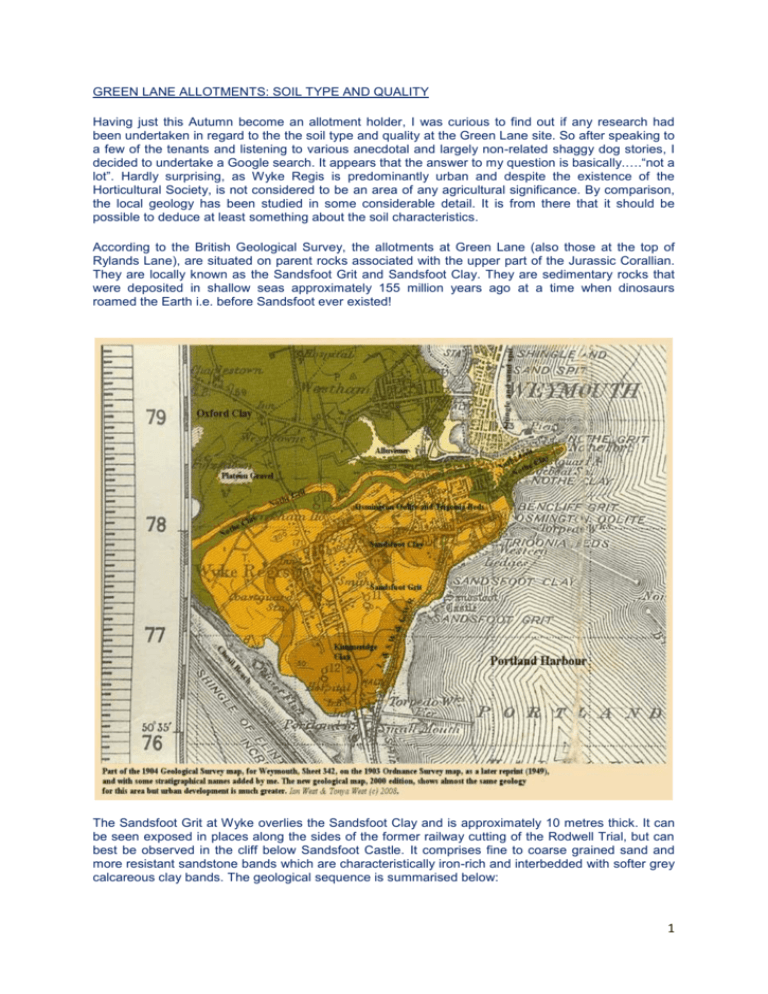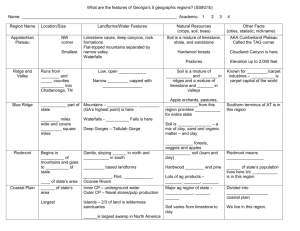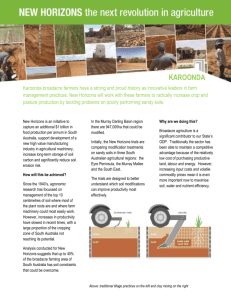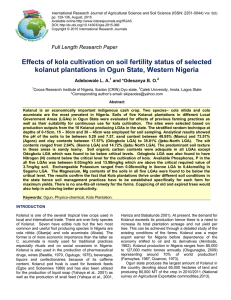GREEN LANE ALLOTMENTS: SOIL TYPE AND QUALITY Having
advertisement

GREEN LANE ALLOTMENTS: SOIL TYPE AND QUALITY Having just this Autumn become an allotment holder, I was curious to find out if any research had been undertaken in regard to the the soil type and quality at the Green Lane site. So after speaking to a few of the tenants and listening to various anecdotal and largely non-related shaggy dog stories, I decided to undertake a Google search. It appears that the answer to my question is basically.….“not a lot”. Hardly surprising, as Wyke Regis is predominantly urban and despite the existence of the Horticultural Society, is not considered to be an area of any agricultural significance. By comparison, the local geology has been studied in some considerable detail. It is from there that it should be possible to deduce at least something about the soil characteristics. According to the British Geological Survey, the allotments at Green Lane (also those at the top of Rylands Lane), are situated on parent rocks associated with the upper part of the Jurassic Corallian. They are locally known as the Sandsfoot Grit and Sandsfoot Clay. They are sedimentary rocks that were deposited in shallow seas approximately 155 million years ago at a time when dinosaurs roamed the Earth i.e. before Sandsfoot ever existed! The Sandsfoot Grit at Wyke overlies the Sandsfoot Clay and is approximately 10 metres thick. It can be seen exposed in places along the sides of the former railway cutting of the Rodwell Trial, but can best be observed in the cliff below Sandsfoot Castle. It comprises fine to coarse grained sand and more resistant sandstone bands which are characteristically iron-rich and interbedded with softer grey calcareous clay bands. The geological sequence is summarised below: 1 A cross-section from Smallmouth Cove to The Nothe shows how the Sandsfoot Grit forms much of the higher ground south of the River Wey. 2 So how is this all relevant to the soil quality? Well, as practising horticulturists we know that to grow strong and healthy fruit and vegetables that the soil ideally needs to have a crumbly texture, needs to be well-drained and have a fairly neutral pH. Most importantly, it also needs to contain and be able to retain essential plant nutrients, in particular Potassium (K), Phosphorus (P) and Nitrogen (N). According to the NERC (Natural Environment Research Council), the soils derived from the Sandsfoot Grit have a slightly acidic pH (around 6.0) and can be described as light sandy to medium sandy. They have a high iron and high calcium carbonate content. The high iron content gives the soils their characteristic orange brown (rust) colour. Iron is an important micronutrient as is Boron, Chlorine, Copper, Manganese, Molybdenum and Zinc. Iron is required for the production of chlorophyll and is therefore necessary for the production of healthy green-leaved vegetables and plants. A deficiency of iron can under alkaline conditions lead to chlorosis and consequently, is an ailment that we should not need to be too concerned about. The majority of the plots at Green Lane appear to contain soil that meets the NERC light to medium sandy description and given the right weather conditions, is fairly easy to work with. There is no doubt however, that the soil also has a high clay content, as is evident from it’s cohesive sticky nature when wet and it’s somewhat annoying tendency to stick to your tools and boots! The BGS plan indicates that the lowermost plots are located on Sandsfoot Clay whereas those on the higher ground are located on Sandsfoot Grit. The boundary between the Sandsfoot Clay and Grit runs diagonally across the site from southwest to northeast. The fact that the plots on the lower ground are prone to waterlogging is a further indication that the parent rock in that area contains a higher percentage of clay. The BGS map also indicates that there is no superficial covering of glacially-derived material (typically gravel) or river-derived deposits (alluvium). This explains why there are very few of the stones or flints that are widespread in the south east of England and which are commonly associated soils on the Chalk. As Alan Titchmarsh will have you know, the best soils for allotments are those which have been well worked over a period of time and which contain a high amount of organic material (humus). Whether they are sandy or clayey, such soils normally contain the essential plant nutrients (K,P and N) and are typically dark grey in colour. Intensive crop growing consumes nutrients. Hence, the reason why allotment growers need to spend so much time improving the soil and adding lots of fertiliser. Meanwhile, digging it over on a regular basis helps to improve drainage and provides aeration. So don’t concern yourself too much about the geology….just make the soil look darker and lighter in texture and you really can’t go far wrong! Peter Pearce (Geoscientist - Plot 24A) December 2012 3





